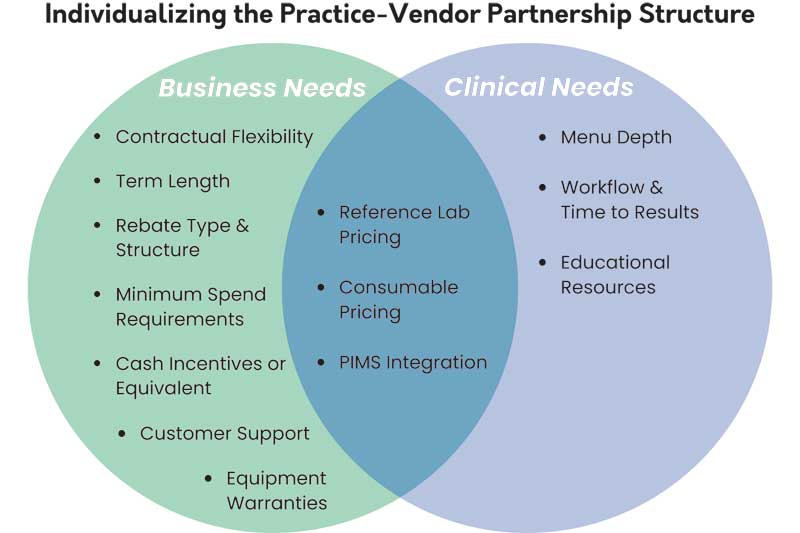
For years, the veterinary industry has touted the power laboratory services can bring to practices’ bottom lines, hyping enigmatic industry benchmarks while continually pushing to expand the depth and breadth of diagnostics. However, this continued frenzy largely fails to support practices in implementing sustainable strategies for careful management of their complex laboratory services.
Tangible know-how, such as identifying and advocating for practices’ individual and complex needs from laboratory vendors and determining truly profitable pricing and communication methods that encourage accessibility is still, unfortunately, rare and highly sought after.
Vendor management
Vendor management is not yet a common term in veterinary business, yet is an integral part of everyday practice. Managing and balancing vendor costs with value received is critical, but knowledge and successful strategies are often quiet, internal secrets.
Vendors hold confidential laboratory agreements—including contract components, terms, and pricing—with thousands of practices, limiting collective, open knowledge. Demand for this super niche knowledge often falsely elevates the presumed importance of any one component. For example, if a practice manager learns of special pricing for one or two reference laboratory tests given to another practice, that information only represents part of a much larger equation. While competitive reference laboratory test pricing is an important part of a strong practice-vendor partnership, in this example, this information sits alone in a silo. It is not interpreted alongside many other components, including rebate type, strength, and structure, term length, minimum structure, consumable discounts, menu depth, educational support, level of PIMS integration, level of customer service, and other incentives. Spoiler—even if it did, every practice’s current and forecasted business and clinical needs are unique, making these details less helpful, pushing this external knowledge into the “helpful guidelines” category.
| “Vendors hold confidential laboratory agreements—including contract components, terms, and pricing—with thousands of practices, limiting collective, open knowledge. Demand for this super niche knowledge often falsely elevates the presumed importance of any one component.” |
Identifying the needs
So, how do you know what is the best-fitting vendor partnership for your practice? It’s likely a few laboratory vendors will be a good fit for a specific practice, but using the practice’s well-defined priorities as a guide can reveal the best-fitting partnership.
Start with identifying the clinical needs of the practice, as providing veterinary care sits at its core. This could be as simple as “small animal general practice” or “equine ambulatory practice,” but practice managers would be wise to dig deeper and consider current alongside future needs. For example, do the veterinarians want access to specific tests, or are they comfortable with standard workups and panels? What analytes and components are part of those workups and panels? Depending on the assays desired, this may limit the vendors available due to patents and general availability.
For some assay components, a workaround may be available through a different platform from another vendor, or perhaps a manual method, but this comes at the expense of an efficient workflow and simplified inventory management.
Similarly, the clinical diagnostic needs of emergency care differ from routine general practice, as a general practice may elect to not invest in any in-house laboratory equipment and testing, but instead solely rely on reference laboratory testing.
The opposite is likely true for many emergency practices, where point-of-care diagnostics are critical for ruling out differentials and contributing towards positive patient outcomes. Practices with low or high reference laboratory volumes may benefit from partnering with laboratory vendors who offer no volume requirements or volume-based discounting, respectively. If practices require significant in-house testing, some vendors may structure laboratory agreements with a rebate that includes in-house spend on consumables.
Another clinical need to balance is how to preserve the team’s hard-earned education and technical laboratory skills with the availability of plug-and-play analyzers that can run more than CBCs and chemistries. Machines that can create, stain, and photograph blood smears; photograph slides for remote cytology; and use AI to interpret blood smears and urinalysis slides are currently or imminently available by Q1 2024.
Not every team finds enjoyment in advanced laboratory work: some teams loathe it, while others enjoy the complexities and continued-learning opportunities. Investing in advanced equipment that provides accurate, comprehensive results to effectively delegate some laboratory testing away from the team may be a great fit for some practices. However, practices should be aware that this increased utilization of laboratory equipment will likely morph into dependency over time as their teams’ skills erode. This action may also permanently move the profit from those manual laboratory techniques off the practice’s P&L statements and onto the laboratory vendors’.
Given the required minimum spends often present in vendor contracts today, practices may be forced to continue outsourcing those tests to avoid contractual penalties.
Other considerations
The next important category of priorities revolves around the practice’s business, directly correlating with staff efficiency, affordability and flexibility for the practice, and client pricing.
- Staff efficiency is greatly improved with bidirectional PIMS integration, though not every PIMS is perfectly compatible with all laboratory vendors’ operating systems. Beware of planned PIMS integrations, as those timelines can shift or evaporate.
- Contractual flexibility can be a priority for practices, especially as some have been burned by restrictive contracts in the past. Depending on competitive market pressures, some laboratory vendors have modified proposed term lengths, or replaced duration with minimum total spend. Other vendors offer no-contract or fixed pricing options. Shifting vendor ownership can also play a role. Some practices may prefer to partner with independent vendors or seek additional benefits by consolidating in-house and reference laboratory spend with one vendor.
- Client pricing. A significant concern of many practice managers is minimizing the cost of laboratory services, including reference laboratory testing, consumables, and laboratory equipment. Several unseen conditions contribute constant pressure to pull prices lower.
First, minimizing expenses is an inherent priority of businesses looking to maintain profitability or non-profit organizations seeking to not overwhelm funding capabilities. As demand for veterinary care seems to normalize from peak pandemic levels, this margin becomes even more critical and challenging to achieve.
Beyond minimizing expenses, determining profitable pricing strategies for laboratory testing is key to preserving a true, sustainable profit margin. “Umbrella multipliers” (e.g. 2.5 x cost) have long been hailed as a magical formula for profitable laboratory testing. However, these nebulous umbrella multipliers likely fail to cover practices’ true overhead, labor, veterinarian’s compensation, consumable, QC, and laboratory equipment costs, in addition to the desired profit. Utilizing cost-based pricing provides a more strategic approach built to cover all true costs incurred and profit. It also identifies a simple fiscal delineation that can be used to gauge the viability of any discounting and forecast effects.
While laboratory costs should ideally be passed onto the consumer, the practice’s budget may limit the initial investment in laboratory diagnostic equipment. To help practices more easily access equipment, laboratory vendors offer different purchasing or leasing structures. Purchasing equipment outright at full MSRP or discounted rates can help reduce financing costs and may benefit the practice through Section 179 tax deductions. If purchasing equipment is prohibitive, financing and leasing options are typically available, though may strain cash flow. - Affordability. Finally, there is a widely held belief laboratory testing needs to be at an accessible price point for pet owners, depending on the practice’s target market. This is often the impetus for discounting testing at time of service to boost client compliance for laboratory diagnostics. However, practice management should be aware that relatively high prices alone do not limit client compliance, rather it is the combination of both high prices and the method practices employ to collect payment.
For years—if not decades, veterinary practices have leaned heavily on “payment-due-at-time-of-service”-thinking. Fortunately, mindsets are shifting to look at other ways to improve accessibility. External financing options have become available to pet owners, though approval rates and practice fees are often obscured. External professionally managed payment plans are gaining popularity for their flexibility and their success in putting the veterinary team back in the driver seat when determining who is eligible for a fully customizable payment plan.
Indeed, an independent review of six years of externally-managed payment plan data found “91.1 percent of financed amounts were ultimately repaid, with 94.0 percent of total care costs paid via installments and down payments…The implications for non-profits working to address access to care is that by directing donor dollars to cover the 6.9 percent that is potentially left unpaid in meeting pet families simply facing cash flow challenges, a non-profit clinic could provide 14.5 times the veterinary care vs. full subsidies. In for-profit clinics, allocating some of a clinic’s discount budget may similarly yield 14.5 times the care for clients likely to be declined by the traditional credit options.”
Beyond the payment methods utilized, some practices have hoped pet insurance would help bridge the accessibility gap. While it has shown limitations thus far, it has allowed some pet owners to access a high level of care.
Striving to obtain external benchmarks for laboratory testing can put undue burdens on practices. External benchmarks reflect external conditions that apply to external practices. Practice managers should instead focus on strategically managing their laboratory services by reasonably reining in laboratory expenses, boosting efficiency, ensuring desired profitability (which likely includes expanding payment methods and mitigating accounts receivable), and maintaining accurate, trustworthy laboratory services. Over time, creating internal benchmarks or guidelines may become helpful to identify areas for further improvement.

Understanding how laboratory vendor contractual terms and components relate to the practice is critical to crafting a strong practice-vendor partnership.
Practice managers and owners should embrace nuanced laboratory vendor management. Avoiding the internal and external conversations required to facilitate successful laboratory management could lead to difficulties and painful lessons down the line, plus cause the practice to miss out on significant profit and other numerous benefits.
It can be a complicated dance with a simple goal: get the most from your laboratory services. The ultimate goal is to cultivate a great relationship with a vendor who helps your team practice medicine the way they want while improving practice efficiency at a fair cost to the practice and pet owners.
Rachel A. Lemcke, BS, MS, is the founder of Amwell Data Services, a full-service independent veterinary laboratory consulting agency.
Reference
- Cammisa, Heather J., and Samantha Hill. “Payment Options: An Analysis of 6 Years of Payment Plan Data and Potential Implications for for-Profit Clinics, Non-Profit Veterinary Providers, and Funders to Access to Care Initiatives.” Frontiers in Veterinary Science 9 (2022). https://doi.org/10.3389/fvets.2022.895532.
